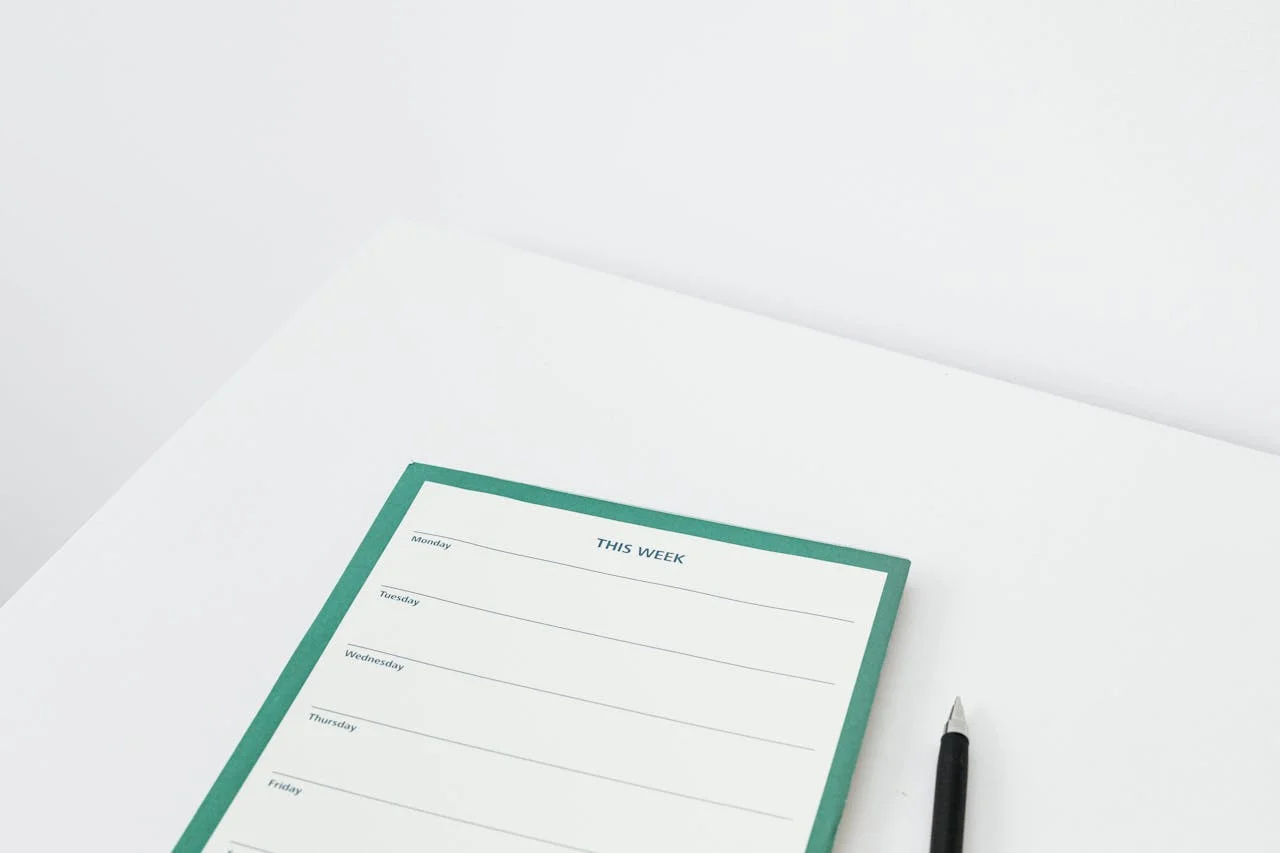
You know how mornings can feel like you’re trying to solve a Rubik’s cube while half-asleep? I’ve been there, stumbling around my kitchen wondering where I put my keys for the third time this week. The thing is, I’ve discovered that having ADHD doesn’t mean you’re doomed to chaotic mornings forever, and honestly, some of the strategies I’ve learned have turned my previously frantic routine into something that actually works. Here’s what’s made all the difference.
Key Takeaways
- Prepare everything the night before including clothes, work bag, and coffee maker to reduce morning decision fatigue.
- Use visual cues like Post-it notes, placing vitamins on coffee makers, and bright reminders to trigger memory.
- Create simple 4-6 item morning checklists using phone apps to stay organized without feeling overwhelmed.
- Start with physical movement like stretching or dancing to boost neurochemicals and improve focus.
- Build 15-20 minutes of buffer time into your schedule to accommodate unexpected delays or disruptions.
Prepare Everything the Night Before
When you’ve got ADHD, mornings can feel like you’re fumbling around in a fog while your brain slowly boots up like an ancient computer, which is why I’ve learned that preparing everything the night before isn’t just helpful—it’s absolutely essential for maintaining my sanity.
I’ve noticed that my evening brain is infinitely more capable of making decisions than my morning zombie-self, so I use that to my advantage by laying out clothes, packing my work bag, and setting up my coffee maker with a timer.
In my experience, even something as simple as placing my keys, wallet, and phone in the same designated spot transforms chaotic mornings into smooth operations, giving you the power to start each day feeling prepared rather than perpetually behind.
Consider keeping duplicates of essentials like phone chargers, keys, or toiletries in multiple locations throughout your home, so even if you forget to prep the night before, you’ll have backup options readily available without having to search.
Use Visual Cues and Reminders
Since my ADHD brain treats visual information like a flashing neon sign compared to the barely visible whisper of verbal reminders, I’ve discovered that strategically placing colorful sticky notes, phone alarms with custom labels, and even my toothbrush in weird spots creates an impossible-to-ignore system that actually works.
I’ve noticed that putting my vitamins directly on my coffee maker forces me to see them every morning, while a bright yellow Post-it on my bathroom mirror reminds me to grab my lunch from the fridge. In my experience, the key is making these cues so obvious they’re borderline obnoxious – I literally tape my car keys to my water bottle so I can’t possibly forget either one, and honestly, it’s saved me countless frantic searches.
Creating a visual checklist of your morning tasks and posting it somewhere you can’t miss it helps ensure you don’t skip important steps in your routine.
Create a Simple Morning Checklist
Building on those visual cues, I’ve found that my ADHD brain also craves the satisfying dopamine hit of checking items off a list, which is exactly why I created a stupidly simple morning checklist that lives on my phone and contains maybe six realistic tasks like “brush teeth,” “grab lunch,” and “take meds.”
In my experience, the magic happens when you keep it short enough that you won’t feel overwhelmed before you even start your day – I learned this the hard way after creating a 15-item monster checklist that made me want to crawl back into bed, so now I stick to the absolute basics that I can actually accomplish without my brain going into shutdown mode.
The magic happens when you keep it short enough that you won’t feel overwhelmed before you even start your day.
This approach works because ADHD brains have lower dopamine levels, which means we need those frequent, achievable wins to maintain motivation throughout our morning routine.
- Keep it stupidly simple – limit yourself to 4-6 essential tasks maximum
- Use your phone’s built-in reminders – I swear by iPhone’s basic checklist app
- Include medication reminders – because we’ve all forgotten our meds before coffee
- Add one “grab and go” item – keys, wallet, work badge, whatever you always forget
Start With Movement to Wake up Your Brain
Although I used to think morning exercise was something only those annoyingly peppy people did, I’ve discovered that getting my body moving for just five to ten minutes actually works like a magic switch for my ADHD brain – and I’m talking about ridiculously gentle movement here, not some intense CrossFit situation that’ll make you sweat through your work clothes.
In my experience, simple stretches, jumping jacks, or even dancing to two songs while making coffee creates the neurochemical boost you need to tackle your day with focus and energy. I’ve noticed that when I skip this step, my brain feels like it’s running through molasses until at least noon, but those few minutes of movement literally wake up my prefrontal cortex and give you the mental clarity to execute your morning checklist.
This morning movement ritual is especially helpful for quieting the racing thoughts that can make it nearly impossible to focus on your daily tasks and priorities.
Build in Buffer Time for Unexpected Delays
You’ll discover that even the most carefully planned morning can go sideways when you can’t find your keys, your coffee maker decides to break, or you realize you forgot to charge your phone overnight, which is why I’ve learned to build buffer time into every part of my routine.
In my experience, adding an extra fifteen to twenty minutes to your morning schedule acts like a safety net that prevents those inevitable ADHD moments from turning into full-blown panic mode, and I’ve noticed this simple strategy transforms chaotic rushes into manageable hiccups.
The key lies in understanding how to strategically plan for extra time and developing quick recovery methods for when your morning hits those unexpected speed bumps that seem to love targeting us right when we’re already running late.
This buffer time also helps maintain your circadian rhythm by reducing the stress and chaos that can throw off your body’s natural sleep-wake cycle, making it easier to stick with your routine long-term.
Extra Time Planning Strategies
When I first started trying to get anywhere on time with ADHD, I’d calculate exactly how long each task would take and plan my morning down to the minute—which worked about as well as you’d expect, meaning I was still rushing out the door with wet hair and mismatched socks.
The game-changer came when I started planning for reality instead of my ideal fantasy version. Here’s what actually works:
- Double your time estimates – If you think something takes 10 minutes, plan for 20, because I’ve noticed we’re notoriously bad at estimating
- Add a 15-minute “chaos buffer” – This covers dropped coffee, forgotten keys, or that mysterious shoe disappearance
- Build in “reset moments” – Plan two-minute breathing breaks between tasks
- Create backup plans – Keep granola bars ready when breakfast burns
Handling Morning Disruptions
Even with all the buffer time in the world, mornings have this uncanny ability to throw curveballs that make your carefully planned routine crumble like a stale cookie, and I’ve learned that accepting disruptions as inevitable rather than fighting them has been the key to maintaining my sanity.
I’ve discovered that having a mental toolkit for common disasters gives me back control when chaos strikes. Here’s my go-to emergency action plan:
| Disruption Type | Quick Fix | Backup Plan |
|---|---|---|
| Can’t find keys | Check yesterday’s pants pockets | Use spare set by door |
| Spilled coffee on shirt | Keep backup shirt in car | Wear jacket over stain |
| Traffic jam | Take alternate route via GPS | Call ahead to reschedule |
| Forgot lunch | Drive-through breakfast place | Office vending machine fund |
| Dead phone battery | Car charger ready | Portable battery pack |
In my experience, these simple preparations transform morning meltdowns into minor inconveniences.
Establish a Consistent Wake-Up Time
You’ve likely discovered, like I have, that your ADHD brain craves predictability even when it rebels against routine, which is why establishing a consistent wake-up time becomes your morning routine’s most essential anchor point.
I’ve noticed that when you set a solid sleep schedule foundation, your body’s internal clock starts working with you instead of against you, making those groggy morning moments far more manageable and predictable.
In my experience, you’ll need to pair this consistency with multiple alarm strategies because let’s face it, one alarm rarely cuts it for our wonderfully scattered brains, and having backup plans prevents those panic-inducing oversleep disasters that can derail your entire day.
This structured approach is particularly important since women with ADHD often experience that constant feeling of juggling multiple tasks throughout the day, making a solid morning foundation even more crucial for overall daily success.
Set Sleep Schedule Foundation
Although it might sound counterintuitive, I’ve discovered that the secret to conquering chaotic ADHD mornings actually begins the night before with establishing a rock-solid wake-up time that doesn’t budge, even on weekends.
I’ve noticed that when I commit to the same wake-up time daily, my ADHD brain stops fighting the process and actually starts cooperating. In my experience, this consistency creates a powerful foundation that makes everything else flow more smoothly.
- Choose your non-negotiable wake-up time – Pick a realistic time you can maintain seven days a week, even if it means saying goodbye to those luxurious Saturday sleep-ins
- Set multiple alarms – I use three alarms spaced five minutes apart on my phone
- Place your alarm across the room – This forces you to physically get up
- Track your consistency – Use a simple habit tracker app
Use Multiple Alarm Strategies
Setting that consistent wake-up time means nothing if you can’t actually drag yourself out of bed when those alarms start screaming, and I’ve learned through years of trial and error that relying on a single alarm is like betting your entire morning routine on one fragile thread.
I’ve noticed that staggered alarms work best – set three alarms fifteen minutes apart, using different tones and devices. Place your phone across the room so you’re forced to physically get up, then use your smartwatch as backup since it vibrates directly on your wrist.
In my experience, apps like Sleep Cycle help by waking you during lighter sleep phases, making that shift from unconscious to functional human slightly less brutal and more strategic.
Use Timers to Stay on Track
When your ADHD brain treats time like a mysterious, ever-shifting concept, I’ve found that timers become your most reliable morning allies, turning those chaotic “I’ll just brush my teeth for two minutes” moments into actual two-minute tasks.
I’ve noticed that visual timers work particularly well since they show time passing, unlike my phone’s basic countdown. In my experience, these strategies transform morning chaos into manageable portions:
- Set a 15-minute “get dressed” timer – I use my Apple Watch’s haptic feedback to prevent those “staring at my closet for twenty minutes” disasters.
- Create 5-minute bathroom blocks – toothbrushing, face washing, and hair become separate timed events.
- Use kitchen timers for breakfast prep – my old-school analog timer keeps me from burning toast while daydreaming.
- Set interval alarms – 10-minute warnings before leaving house.
Remember that consistency beats intensity when building these timer habits into your morning routine, so start with just one or two timed activities and gradually add more as they become automatic.
Minimize Decision-Making With Preset Routines
Decision fatigue hits hardest in the morning when your ADHD brain is already juggling a million thoughts, so I’ve learned that preset routines become your secret weapon for smoother starts. In my experience, when you eliminate choices like “what should I wear” or “what’s for breakfast” by deciding these things the night before, you free up precious mental energy for the tasks that actually matter.
I’ve noticed that automating these daily decisions through evening prep sessions, whether it’s laying out tomorrow’s outfit or setting up your coffee maker on a timer, transforms chaotic mornings into predictable, manageable sequences that work with your brain instead of against it. This approach leverages automation tools to reduce your mental load, allowing you to save your cognitive resources for the creative and important work that comes later in your day.
Pre-Plan Evening Preparations
Although your ADHD brain might rebel against the idea of evening prep work, I’ve discovered that spending just fifteen minutes before bed organizing tomorrow’s essentials can transform your mornings from chaotic scrambles into surprisingly smooth operations.
In my experience, this evening ritual becomes your secret weapon against morning decision fatigue, and I’ve noticed these four preparations make the biggest difference:
- Lay out complete outfits including underwear, socks, and accessories on your dresser or chair
- Pack your work bag with laptop, chargers, documents, and anything you’ll need the next day
- Prepare breakfast components like setting out cereal boxes, filling the coffee maker, or prepping overnight oats
- Position keys, wallet, and phone in one designated spot near your exit door
Automate Daily Choices
Building on that evening preparation foundation, I’ve learned that creating preset routines for your most frequent daily decisions can dramatically reduce the mental energy you spend on mundane choices, freeing up your ADHD brain for more important tasks throughout the day. In my experience, decision fatigue hits us harder than neurotypical folks, so I’ve developed this simple automation system that’s honestly been a game-changer.
| Morning Decision | Automated Solution |
|---|---|
| What to wear | Weekly outfit planning on Sundays |
| What to eat | Rotate between 3-4 breakfast options |
| Daily priorities | Use same task app with templates |
I’ve noticed that when I eliminate these small choices, my mornings flow smoother, and I actually arrive at work feeling more confident and in control.
Incorporate Mindfulness or Breathing Exercises
When I first heard about adding mindfulness to my morning routine, I’ll admit I rolled my eyes so hard I practically saw my own brain – because let’s be honest, the last thing my scattered ADHD mind needed was another task to recall. But here’s what I’ve discovered: you don’t need to transform into some zen master, you just need strategies that actually work with your brain’s wiring.
In my experience, these approaches have been game-changers:
- Box breathing for 2 minutes – inhale for 4 counts, hold for 4, exhale for 4, hold for 4
- Body scan while still in bed – notice tension from head to toe before getting up
- Mindful coffee ritual – focus completely on brewing and that first sip
- Gratitude snapshots – mentally capture three specific moments you’re grateful for
The key is creating a space that feels nurturing rather than demanding, where these practices become gentle anchors rather than rigid requirements.
Design Your Environment for Success
Since my ADHD brain operates like a goldfish swimming through molasses on most mornings, I’ve learned that setting up my environment the night before is absolutely essential – and I mean this literally saves my sanity every single day.
I’ve noticed that when I place my coffee mug next to the machine, lay out tomorrow’s clothes on my dresser, and put my keys in the same bowl by the door, mornings become surprisingly manageable instead of chaotic treasure hunts.
In my experience, visual cues work better than mental reminders, so I keep a small whiteboard on my bathroom mirror with three simple checkboxes for brushing teeth, taking medication, and grabbing lunch, because let’s be honest, without these concrete prompts I’d probably forget my own name some mornings.
This approach works because physical space organization creates predictable routines that reduce decision fatigue and help maintain focus throughout the morning rush.
Conclusion
Building an ADHD-friendly morning routine isn’t about perfection, it’s about progress, and I’ve learned that even implementing two or three of these strategies can make a significant difference in how your day unfolds. You’ll probably stumble sometimes—I still forget to set out my keys occasionally—but consistency beats perfection every time, so start small, be patient with yourself, and celebrate those wins.





Leave a Reply